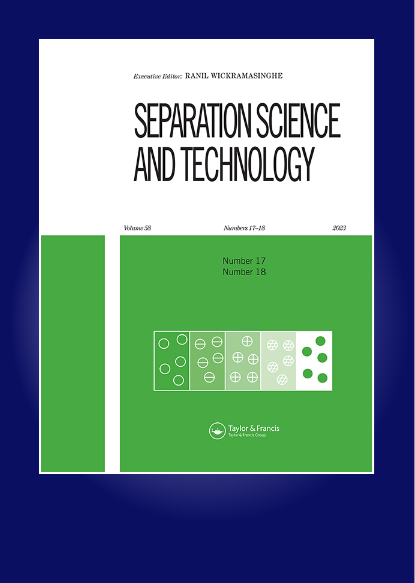Experimental investigation of reactive extraction of p-hydroxybenzoic acid using TOA in toluene, petroleum ether and MIBK
IF 2.3
4区 工程技术
Q3 CHEMISTRY, MULTIDISCIPLINARY
引用次数: 0
Abstract
ABSTRACT p-hydroxybenzoic acid (p-HBA) remains present in various industrial effluents, it has various industrial applications and excellent medicinal properties, on the contrary, it degrades the fertility of soil if discharged in atmosphere hence, retrieval of p-HBA from effluent is a mandate. In past decades, reactive extraction has arisen as an efficient and attractive separation technique. Therefore, in the present study, the reactive extraction of p-HBA, using Tri-n-octylamine diluted in toluene, petroleum ether, and methyl isobutyl ketone, has been investigated. The results have been reported in terms of efficiency, distribution coefficient, equilibrium complexation constant, and loading ratio. The order of diluents, with respect to extraction given, is MIBK (93.43%) > toluene (92.57%)> petroleum ether (91.43%). The relative basicity model is used to for the interpretation and is found suitable for explaining the results. The diffusion coefficient was also found using Reddy Doraiswamy equation and Wilke Chang equation. Further, minimum number of stages of counter current extraction column and solvent to feed ratio were also calculated to investigate the feasibility of the process.在甲苯、石油醚和 MIBK 中使用 TOA 反应萃取对羟基苯甲酸的实验研究
摘要 对羟基苯甲酸(p-HBA)存在于各种工业废水中,它具有多种工业用途和出色的药用特性,相反,如果排放到大气中会降低土壤的肥力,因此,从废水中回收对羟基苯甲酸是一项任务。在过去的几十年中,反应萃取已成为一种高效且极具吸引力的分离技术。因此,在本研究中,使用稀释在甲苯、石油醚和甲基异丁基酮中的三正辛胺对 p-HBA 进行了反应萃取。研究结果从效率、分配系数、平衡络合常数和负载率等方面进行了报告。稀释剂的萃取率依次为甲基异丁基酮(93.43%)>甲苯(92.57%)>石油醚(91.43%)。使用相对碱性模型进行解释,发现该模型适用于解释结果。还利用 Reddy Doraiswamy 方程和 Wilke Chang 方程计算了扩散系数。此外,还计算了逆流提取柱的最小级数和溶剂与进料比,以研究该工艺的可行性。
本文章由计算机程序翻译,如有差异,请以英文原文为准。
求助全文
约1分钟内获得全文
求助全文
来源期刊

Separation Science and Technology
工程技术-工程:化工
CiteScore
6.10
自引率
3.60%
发文量
131
审稿时长
5.7 months
期刊介绍:
This international journal deals with fundamental and applied aspects of separation processes related to a number of fields. A wide range of topics are covered in the journal including adsorption, membranes, extraction, distillation, absorption, centrifugation, crystallization, precipitation, reactive separations, hybrid processes, continuous separations, carbon capture, flocculation and magnetic separations. The journal focuses on state of the art preparative separations and theoretical contributions to the field of separation science. Applications include environmental, energy, water, and biotechnology. The journal does not publish analytical separation papers unless they contain new fundamental contributions to the field of separation science.
 求助内容:
求助内容: 应助结果提醒方式:
应助结果提醒方式:


